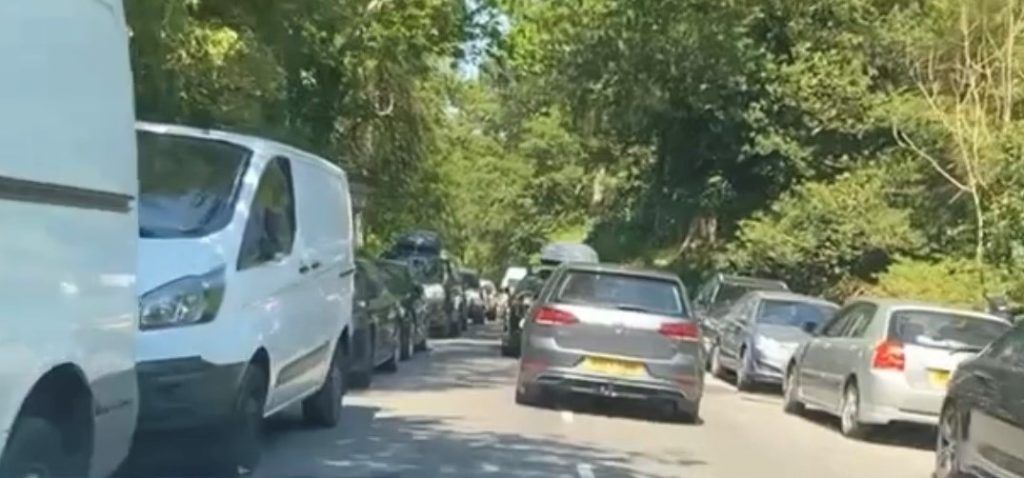
Keswick, Borrowdale and Portinscale could be looking at another summer of bumper-to-bumper car chaos.
A new report has shown that a solution to the mass invasion of motorists in and out of the valley remains as elusive as ever with Lake District national park bosses realistic that there is no “quick fix”.
In a sign of how serious problem parking and congestion got around Derwentwater last year, a new area action plan drawn-up by the authorities, suggests that organisations involved in tourism “stop promoting” Catbells and Portinscale on social media this season.
It has also been suggested that under-pressure valleys such as Wasdale and Buttermere should not be trailed in marketing materials aimed at visitors.
While a new action plan has been drawn-up to help tackle the season ahead, a report heading to a national park committee meeting after next week’s bank holiday suggests that finding a solution to one of the biggest problems – traffic gridlock from Borrowdale to Keswick – remains a “challenge”.
At a heated meeting in The Institute last October, councils, the police and the national park authority, came in for criticism from Borrowdale residents.
They complained that the valley was “inundated” at peak times last summer with reports of ugly confrontations between motorists and local residents over problem parking.
The meeting saw demands for tougher action from the authorities this summer.
The public had called for new measures such as a long extension of double yellow lines in the Borrowdale valley, more pop-up car parks, a dedicated traffic warden for the area, and more intervention from police and councils.
Former Keswick councillor and national park member Tony Lywood, who organised the meeting in Borrowdale last autumn, branded this year’s proposals as a “fudge and a nonsense”.
Cllr Lywood told the Reminder: “On the one hand the Lake District National Park encourages yet more visitors and extols the virtues of visiting the park at every opportunity, and then the very same authority holds up its hands in horror as the arrival of cars causes issues and doesn’t quite fit in with their green agenda. It’s like an overweight man trying to go on a diet by ordering more food.
“The reality is that if we have more cars, then we need more car parks. These can be tree-covered and discrete but we need them. Without more car parks the scenes of gridlock and chaos we have seen over the last few years will only proliferate. Our visitors don’t want a bad, traumatic and troublesome experience, they want it easy, tidy and enjoyable.”
The new plan pledges to “monitor parking” in the Catbells and Portinscale area and to “consider” raising fines and “continuing” with enforcement.
In March, a revised scheme for a 150-space car park plan for the Portinscale and Catbells area was withdrawn by the applicants at the 11th hour, after national park planning officers recommended that it be refused, after previous plans had also been rejected.
Applicants, the Lingholm Private Trust, Portinscale, wanted to provide pay-and-display parking, toilet facilities, a shuttle bus and infrastructure improvements in the area.
But objectors claimed it would only draw more cars and could open the floodgates for large commercial car parks in under-pressure Lakeland valleys.
Such are the problems caused in the Lake District, a multi-agency organisation was established three years ago called the Strategic Visitor Management Group. Its members are Cumberland Council, Cumbria Police, Cumbria Tourism, the LDNPA, National Trust, Forestry England, Westmorland and Furness Council, Highways England and the Lake District Search and Mountain Rescue Association.
Its objective is to reduce pressure on Lake District communities and it has hailed its previous multi-agency work as “outstanding”.
Its new over-arching “tactical visitor action plan” for 2023, agreed this month, contains no less than 36 “priority actions” for partners this year.
These include:
- Encouraging use of sustainable forms of transport such as rail, bus, lake cruises and coach tours;
- Early morning parking enforcement at Buttermere and Wasdale;
- “Considering” emergency traffic regulation orders in problem spots;
- Temporary signage to direct visitors away from full parks to those with capacity;
- A campaign to discourage irresponsible camping and anti-camping signage;
- Promoting a motorhome code of conduct.
Stephen Ratcliffe, director of sustainable development at the LDNPA, and current chair of SVMG, said: “We appreciate that there continues to be visitor and traffic management issues in areas of the Lake District, and that these can impact on our communities, businesses, and the visitor experience.
“The solutions for these are not quick fixes and will be developed with all stakeholders including the community, businesses, and visitors over the coming years and all the partners in the SVMG are committed to continuing to work together to deliver, in the context of the Lake District National Park Partnership’s Management Plan.
“Through positive and constructive partnership working we have made a lot of progress including improved traffic management including new double yellow lines at places where dangerous parking was occurring, this includes in Borrowdale, Catbells, Buttermere, Ullswater, Langdale and Ambleside and more targeted enforcement of this.”








